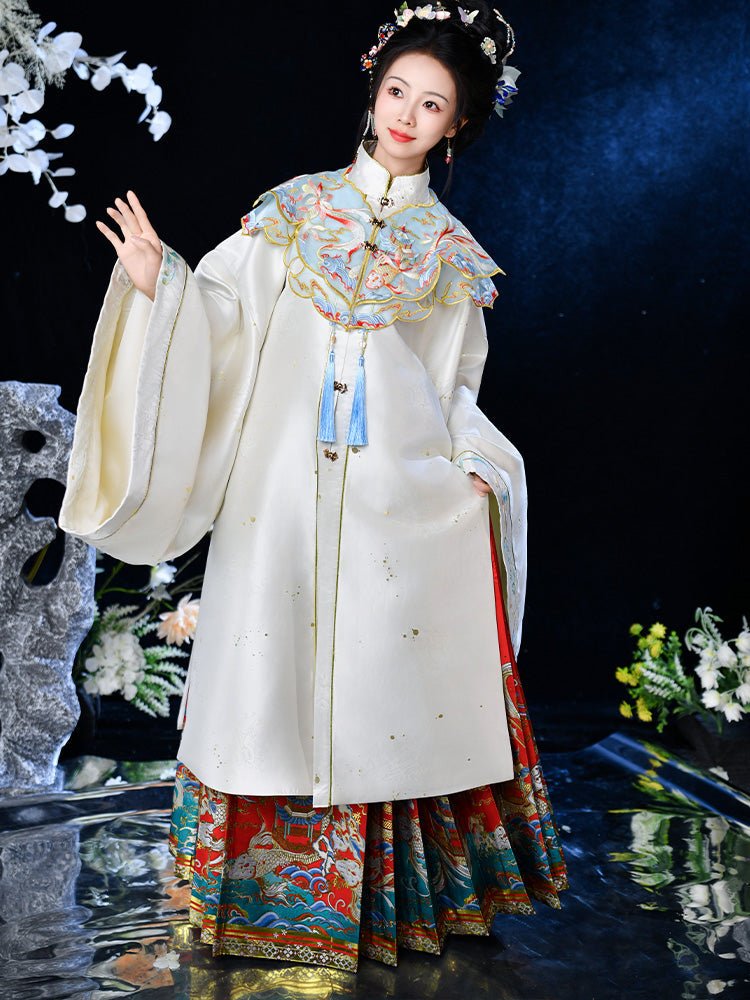Recently, some buyers have asked about the meaning of "Chinese Broken Skirt (Poqun)". Essentially, it is a unique style of skirt in the
Hanfu system, carrying rich historical connotations and cultural values.
The origin of Chinese Broken Skirt (Poqun) can be traced back to the Pre-Qin period (2070 BC - 221 BC). At that time, limited by textile technology and clothing production techniques, people cut fabrics into multiple pieces and then sewed them together to make skirts. This was the prototype of Chinese Broken Skirt (Poqun).
Origin of the character "Po (破)": The skirt is named "Poqun" because it is made by stitching multiple pieces of fabric together.
Early characteristics: It was easy to make, highly practical, and convenient for daily work, so it was mostly worn by working people.
Common styles: "Six-piece Chinese Broken Skirt" and "Eight-piece Chinese Broken Skirt" are easy to understand. "Po (破)" refers to the number of fabric pieces used for stitching. For example, a six-piece Chinese Broken Skirt is made by stitching six pieces of fabric.
For important early cultural relics related to poqun (split skirts) unearthed in China, reference can be made to the No. 1 Chu Tomb in Mashan, Hubei. This is the earliest known tomb in China where ruqun (jacket and skirt) cultural relics have been unearthed. A skirt unearthed from it is made by stitching 8 trapezoidal pieces of fabric that are narrow at the top and wide at the bottom. It is commonly known as duopoqun (multi-split skirt) in modern times, which is poqun (split skirt). In addition, from the murals unearthed in such places as the Tang Dynasty Tomb of Concubine Wei and the Tomb of Concubine Yan in Liquan, Shaanxi, one can see the exquisite color matching of poqun, such as red and white, black and white, green and white, etc., which show the style of poqun in the Tang Dynasty.
-
 ▲36-piece Poqun (made by stitching 36 pieces of fabric)
▲36-piece Poqun (made by stitching 36 pieces of fabric)
- Technological development: The progress of textile technology made the production process of Chinese Broken Skirt (Poqun) more and more refined.
- Wearers: It was widely popular among ordinary people and gradually entered the clothing system of the aristocratic class.
- Style and matching: The hem of the skirt became wider, and it was elegant and flexible when walking. It was often matched with curved-front or straight-front deep robes. The upper garment was tucked into the skirt and fixed with a belt, showing a simple and grand style.
- Historical background: Although the society was turbulent, culture and art flourished, which had an impact on clothing styles.
- Style characteristics: The skirt body became wider and wider, and the design with multiple pleats became a popular trend.
- Matching style: It was often matched with large-sleeved shirts. The wide robes and large sleeves complemented the elegant Chinese Broken Skirt (Poqun), showing the otherworldly and unrestrained demeanor of the Wei and Jin dynasties.
- Peak development: During the Tang Dynasty, with its strong national power and open culture, the production process of Chinese Broken Skirt (Poqun) reached an unprecedented height.
- Style features: It had bright colors and exquisite patterns, and high-waisted Chinese Broken Skirt (Poqun) became a fashion trend.
- Matching style: Matched with short Ru tops (a type of traditional Chinese upper garment) or tops that exposed the chest and arms, it showed the grace and confidence of women. This kind of dressing style was not only popular in the imperial court but also widely spread among ordinary people, becoming one of the representatives of Tang Dynasty clothing culture.
- Historical influence: Its stitching production method provided inspiration for many later skirt styles. Similar stitching elements can also be seen in the costumes of some ethnic minorities. Meanwhile, the elegant and flexible style of Chinese Broken Skirt (Poqun) also influenced the pursuit of clothing aesthetics and wearing comfort in later generations.
- Modern significance: It is highly favored in the modern Hanfu revival movement. In addition, it is very suitable for daily wear and can be matched with various styles of clothes, so it has become a choice for many Hanfu lovers.


 ▲36-piece Poqun (made by stitching 36 pieces of fabric)
▲36-piece Poqun (made by stitching 36 pieces of fabric)


